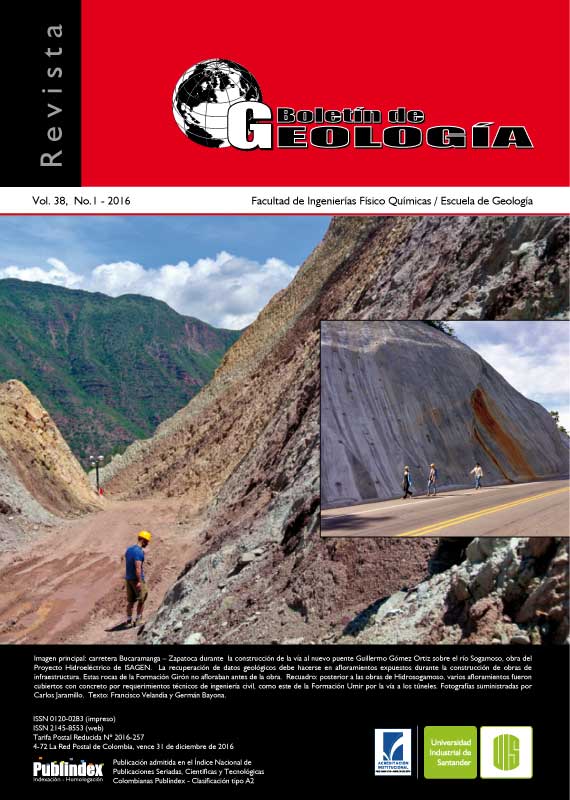Articles
A PROPOSAL TO SPLIT-OFF THE SO-CALLED ‘SILGARÁ FORMATION’ (SANTANDER MASSIF, COLOMBIA) SUPPORTED ON DETRITAL U-Pb ZIRCON AGES
Published 2015-12-04
Keywords
- Colombia,
- Santander Massif,
- metamorphism,
- detrital zircon U-Pb geochronology
How to Cite
Mantilla-Figueroa, L. C., García-Ramírez, C. A., & Valencia, V. A. (2015). A PROPOSAL TO SPLIT-OFF THE SO-CALLED ‘SILGARÁ FORMATION’ (SANTANDER MASSIF, COLOMBIA) SUPPORTED ON DETRITAL U-Pb ZIRCON AGES. Boletín De Geología, 38(1). https://doi.org/10.18273/revbol.v38n1-2016002
Altmetrics
Abstract
The metamorphic lithologies from the Silgará Formation (s.l.) outcropping along the Matanza-Cachirí strip in the Santander Massif (Colombian Eastern Cordillera) are mainly constituted by metapelites and metasemipelites that reached the thermal metamorphic peak in the range of green schist facies. Detrital zircons from these metamorphic lithologies yielded U-Pb ages from 906.5 ± 10.5 to 1610.3 ± 9.8 Ma, suggesting a maximum age of deposition at Neoproterozoic time. On the other hand, the Piedecuesta-Aratoca metamorphic rocks strip (also linked previously to the so-called Silgará Formation) is composed by two groups of lithologies: The lower sequence which is constituted mainly by meta-psamites, semipelites and metabasites with the thermal metamorphic peak at amphibolite facies and; the upper sequence which are basically meta-psamites and semipelites that reached the thermal metamorphic peak at sub-green schist facies. Detrital zircons from the quartzites in amphibolite facies rocks yielded U-Pb ages from 506.7± 9.3 to 2586.9±10.2 Ma, suggesting a maximum age of deposition at Early to Middle Cambrian time; whereas U-Pb zircon ages determinated from the meta-sandstones from the upper sequence yielded ages from 451.6±7.7 to 1611.5±13.6 Ma, suggesting a maximum age of deposition at Late Ordovician (Katina) time. These geochronology data point out that these both sequences have different paleogeographic and sedimentological history. Supported by the aforementioned differences, it is proposed here to split-off the older Silgará Formation (s.l.) in the following three different units: the Silgará schists s.s.(constituted by metapelitic and semipelitic rocks), the Chicamocha schists (mainly constituted by metapsammites, metapelites and metabasites, and possibly metacalcsilicates? rocks outcropping in some others metamorphic strips from the Santander Massif) and the San Pedro phyllites (constituted by metapsamites and metapelites and possibly metavolcanoclastic lithologies?). The thermal metamorphic peak of the Silgara (s.s.) and Chicamocha Schists units must be related to the main Fammatinian orogenic event (locally known as Quetame-Caparonensis, early Ordovician in age), whereas the metamorphic peak for the San Pedro Fillites unit should be related to the minor Fammatinian orogenic event (Silurian in age). Despite both The Silgará Schists (s.s.) and Chicamocha Schists units reached probably the thermal metamorphic peak during the Fammatinian Orogeny, here is proposed to split-off these units, because of these lithological differences (among some others aforementioned characteristics). Anyway, in order to avoid or to support this idea, there is a need to develop new studies, involving more metamorphic strips in order to identify better their lithologies and their maximum deposition ages. The split-off of the San Pedro Phyllites Unit from the Silgara Formation (s.l.) is evident and necessary task, considering their lithologies, metamorphic ages, among others features, compared with the Silgara Schists (s.s.) and Chicamocha Schists Units.Younger tectono-thermal events (mainly dynamo-thermal) are not ruled out, taking into account the local presence of late Paleozoic sedimentary rocks in the Santander Massif, affected by a slaty cleavageDownloads
Download data is not yet available.
